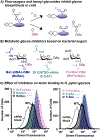Chemical tools to study bacterial glycans: a tale from discovery of glycoproteins to disruption of their function
- PMID: 37324574
- PMCID: PMC10266715
- DOI: 10.1002/ijch.202200050
Chemical tools to study bacterial glycans: a tale from discovery of glycoproteins to disruption of their function
Abstract
Bacteria coat themselves with a dense array of cell envelope glycans that enhance bacterial fitness and promote survival. Despite the importance of bacterial glycans, their systematic study and perturbation remains challenging. Chemical tools have made important inroads toward understanding and altering bacterial glycans. This review describes how pioneering discoveries from Prof. Carolyn Bertozzi's laboratory inspired our laboratory to develop sugar probes to facilitate the study of bacterial glycans. As described below, we used metabolic glycan labelling to install bioorthogonal reporters into bacterial glycans, ultimately permitting the discovery of a protein glycosylation system, the identification of glycosylation genes, and the development of metabolic glycan inhibitors. Our results have provided an approach to screen bacterial glycans and gain insight into their function, even in the absence of detailed structural information.
Keywords: bacteria; bioorthogonal chemistry; glycan; glycoprotein; metabolic labeling.
Figures







Similar articles
-
Metabolic Glycan Labeling-Based Screen to Identify Bacterial Glycosylation Genes.ACS Infect Dis. 2020 Dec 11;6(12):3247-3259. doi: 10.1021/acsinfecdis.0c00612. Epub 2020 Nov 13. ACS Infect Dis. 2020. PMID: 33186014 Free PMC article.
-
Synthesis and Application of Rare Deoxy Amino l-Sugar Analogues to Probe Glycans in Pathogenic Bacteria.ACS Infect Dis. 2022 Apr 8;8(4):889-900. doi: 10.1021/acsinfecdis.2c00060. Epub 2022 Mar 18. ACS Infect Dis. 2022. PMID: 35302355 Free PMC article.
-
Chemical Reporters for Bacterial Glycans: Development and Applications.Chem Rev. 2022 Feb 9;122(3):3336-3413. doi: 10.1021/acs.chemrev.1c00729. Epub 2021 Dec 14. Chem Rev. 2022. PMID: 34905344 Free PMC article. Review.
-
Metabolic inhibitors of bacterial glycan biosynthesis.Chem Sci. 2020 Jan 8;11(7):1761-1774. doi: 10.1039/c9sc05955e. Chem Sci. 2020. PMID: 34123271 Free PMC article.
-
Dismantling the bacterial glycocalyx: Chemical tools to probe, perturb, and image bacterial glycans.Bioorg Med Chem. 2021 Jul 15;42:116268. doi: 10.1016/j.bmc.2021.116268. Epub 2021 Jun 7. Bioorg Med Chem. 2021. PMID: 34130219 Free PMC article. Review.
Cited by
-
Biochemical Applications of Microbial Rare Glycan Biosynthesis, Recognition, and Sequencing.Biochemistry. 2025 Sep 2;64(17):3663-3680. doi: 10.1021/acs.biochem.5c00338. Epub 2025 Aug 20. Biochemistry. 2025. PMID: 40833034 Free PMC article. Review.
-
Selective Glycan Labeling of Mannose-Containing Glycolipids in Mycobacteria.J Am Chem Soc. 2024 Jan 10;146(1):377-385. doi: 10.1021/jacs.3c09495. Epub 2023 Dec 19. J Am Chem Soc. 2024. PMID: 38112296 Free PMC article.
-
Sweet Secrets: Exploring Novel Glycans and Glycoconjugates in the Extracellular Polymeric Substances of "Candidatus Accumulibacter".ACS ES T Water. 2024 Jul 12;4(8):3391-3399. doi: 10.1021/acsestwater.4c00247. eCollection 2024 Aug 9. ACS ES T Water. 2024. PMID: 39144681 Free PMC article.
-
Bio-orthogonal Labeling of Chitin in Native Pathogenic Candida Species via the Chitin Scavenge Pathway.J Am Chem Soc. 2025 Feb 19;147(7):5632-5641. doi: 10.1021/jacs.4c11554. Epub 2025 Feb 9. J Am Chem Soc. 2025. PMID: 39925016
-
Unravelling mechanisms of bacterial recognition by Acanthamoeba: insights into microbial ecology and immune responses.Front Microbiol. 2024 Aug 23;15:1405133. doi: 10.3389/fmicb.2024.1405133. eCollection 2024. Front Microbiol. 2024. PMID: 39247694 Free PMC article. Review.
References
-
- National Research Council Committee on Assessing the Impact of Glycosciences, in Transforming Glycoscience: A Roadmap for the Future, National Academies Press (US), National Academy of Sciences., Washington (DC), 2012. - PubMed
-
- Zhou JY, Cobb BA, Annu Rev Immunol 2021, 39, 511–536. - PubMed
-
- Poole J, Day CJ, von Itzstein M, Paton JC, Jennings MP, Nat Rev Microbiol 2018, 16, 440–452. - PubMed
Grants and funding
LinkOut - more resources
Full Text Sources
Research Materials
